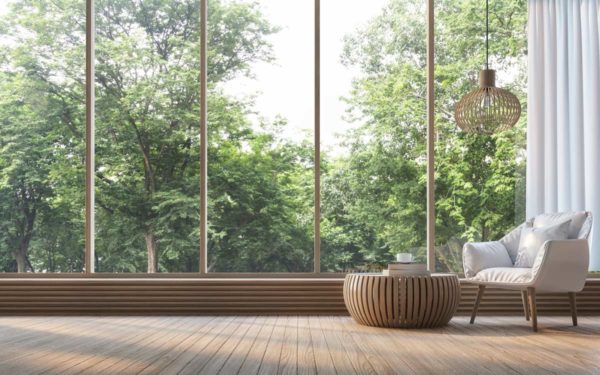
In this article, we will be talking about eco-friendly choices you can make to ensure that you not only improve the aesthetics of your house when you renovate it, but also create a healthier, energy-efficient and environment-friendly indoor atmosphere as well. Moreover, we will also highlight certain practices you can adopt to minimise your waste and energy losses while maximising your energy and cost savings.
What is a Green Home?
A green home is a building that is constructed using sustainable and environment-friendly materials with a focus on maximising energy efficiency and reducing waste. Such homes are built to effectively utilise resources such as water, heat, and electricity in order to reduce energy losses. Green homes may also make use of environment-friendly building fabric and materials like organic paint, natural oils, cellulose insulation, wood, clay, etc. to create low-energy and eco-friendly buildings.
Upgrading to a Green Home
Below, we’ve listed some easy upgrades you can make to your home to make it more environment-friendly and energy-efficient.
Draught-Proof Your Home
Draughts can cause up to an alarming 25% of all energy losses. By sealing off these unwanted cracks, holes, and gaps in your walls, windows, and doors, you can go on to save about £20 a year.
Switch to Energy-Efficient Lighting
If you’re still using those cheap traditional incandescent light bulbs, it is about time you shift to the energy-efficient ones like LEDs and CFLs. While these may be slightly more expensive to buy than the traditional bulbs, LEDs and CFLs prove to be more cost-effective in the long run because they use about 40 to 80 percent lesser energy.
Insulate Your Home
If your house isn’t insulated, it is about time you start considering it. A lot of energy used in heating and cooling is simply lost through poorly insulated walls, windows, and doors. It is estimated that insulating the walls, roof, crawl spaces and loft can save about 11% on the total energy costs.
Purchase Energy-Efficient Appliances
It might seem like an unnecessary change to make in your home, but it is one that will help you cut back on your energy costs. By gradually replacing your old appliances with eco-friendly and energy-efficient ones, you can greatly cut back on energy costs.
To give you an example, energy-efficient refrigerators can use up to 40% less energy than the traditional ones. Similarly, switching over to an energy-efficient clothes washer can help you save about £40 on your total utility bills by using less water and electricity in each cycle.
Glazing Your Windows
Installing glazed windows in your home can help you reduce draughts, heat losses, and erase cold spots. These windows include two to three glass panes stacked as a single unit with gaps in between. The surrounding frame of these windows is usually made of wood or unplasticised polyvinyl chloride (uPVC).
Using Natural and Eco-Friendly Paint
It is no secret that those readily available synthetic paints in the market are loaded with chemicals and components that are very harmful to human health and wellbeing. Volatile organic compounds (VOCs), for one, are largely found in synthetic paints and contribute to respiratory problems, irritation of the eyes and the nose, general discomfort, and air pollution.
By replacing this synthetic paint with environment-friendly, VOC-free, and natural paints, you come quite a few steps closer to making your home a green home.
Installing a Tank-less Water Heater
A tankless water heater works by heating or cooling the quantity of water you need for when you need it. These are quite different from other commonly found water tanks that store water in bulk and maintain it at a constant temperature for use.
These water heaters can allow you to cut back on 20 to 50 percent of your energy costs, which is why these are a must-have in your green home. While these can be very expensive to install, they offer great cost savings in the long run and you’ll be able to break-even in no time.
Eco-Friendly Practices to Minimise your Home’s Carbon Footprint
In addition to making these big changes in your household to make it greener, you can also start to follow some eco-friendly practices to cut back on needless energy costs and improve the energy-efficiency of your home.
1. Turning off unnecessary lights
The importance of switching off extra lights in the house cannot be overstated. Make it a habit to turn off the lights and fans whenever you leave the room to avoid wasting both energy and money
2. Keep your internal doors closed
This small habit can prevent you from heating and cooling other unoccupied rooms in the house. On top of that, it also helps you keep the room you’re in cooler, or warmer, for a longer period.
3. Keeping the curtains closed
One way of preventing draughts and temporarily improving the insulation of your rooms is to keep the curtains drawn after sundown.
4. Air-dry your clothes
If the weather is not too humid on a laundry day, you should definitely opt for naturally drying your clothes instead of putting them in the dryer. This can save you a lot of electricity spent on artificially drying your clothes.
5. Maintain good plumbing
It is always advisable to keep an eye out for dripping taps, valves, and leaks. This can allow you to save around 2 to 5 buckets of water by the end of the year.
Put it all together for some future savings. Invest in the future.
It might seem very financially and physically taxing to upgrade your household to an environment-friendly one, but it is definitely worth the investment. Not only will you effectively decrease your utility bills, but you would also be paving the way for a healthier environment both inside and outside your house. And even if you don’t have the money to make big changes, you can always adopt certain eco-friendly habits to cut back on some unnecessary costs.

Hi! I’m Chris, the founder of The Organic & Natural Paint Co, and I’m focused on the education and promotion of natural non toxic alternatives to chemical laden everyday products that we just take for granted. We have a choice, and I want to raise awareness of alternative products that don’t actually harm us!
This company is my way of pushing the awareness of better indoor air quality, something that I am personally passionate about due to my own children’s breathing medical conditions. I just couldn’t paint with big brand standard petrochemical paint any longer and wanted another solution.
Read more: About me
Twitter: NaturalPaintCo
Instagram: cleanairclubofficial

